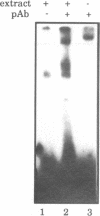Abstract
Bacterial challenge of larvae or adults of Drosophila induces the rapid transcription of several genes encoding antibacterial peptides with a large spectrum of activity. One of these peptides, the 82-residue anti-gram negative diptericin, is encoded by a single intronless gene and we are investigating the control of expression of this gene. Previous studies using both transgenic experiments and footprint analysis have highlighted the role in the induction of this gene of a 30 nucleotide region which contains three partially overlapping motifs with sequence homology to mammalian NF-kappa B and NF-IL6 response elements and to the GAAANN sequence present in the interferon consensus response elements of some mammalian interferon-induced genes. We now show that the latter sequence binds in immune responsive tissues (fat body, blood cells) of Drosophila a approximately 45 kDa polypeptide which cross-reacts with a polyserum directed against mammalian interferon Regulatory Factor-I. Using a transfection assay of Drosophila tumorous blood cells, we show that the GAAANN sequence positively regulates the activity of the diptericin promoter. We propose that this motif cooperatively interacts with the other response elements in the regulation of the diptericin gene expression.
Full text
PDF
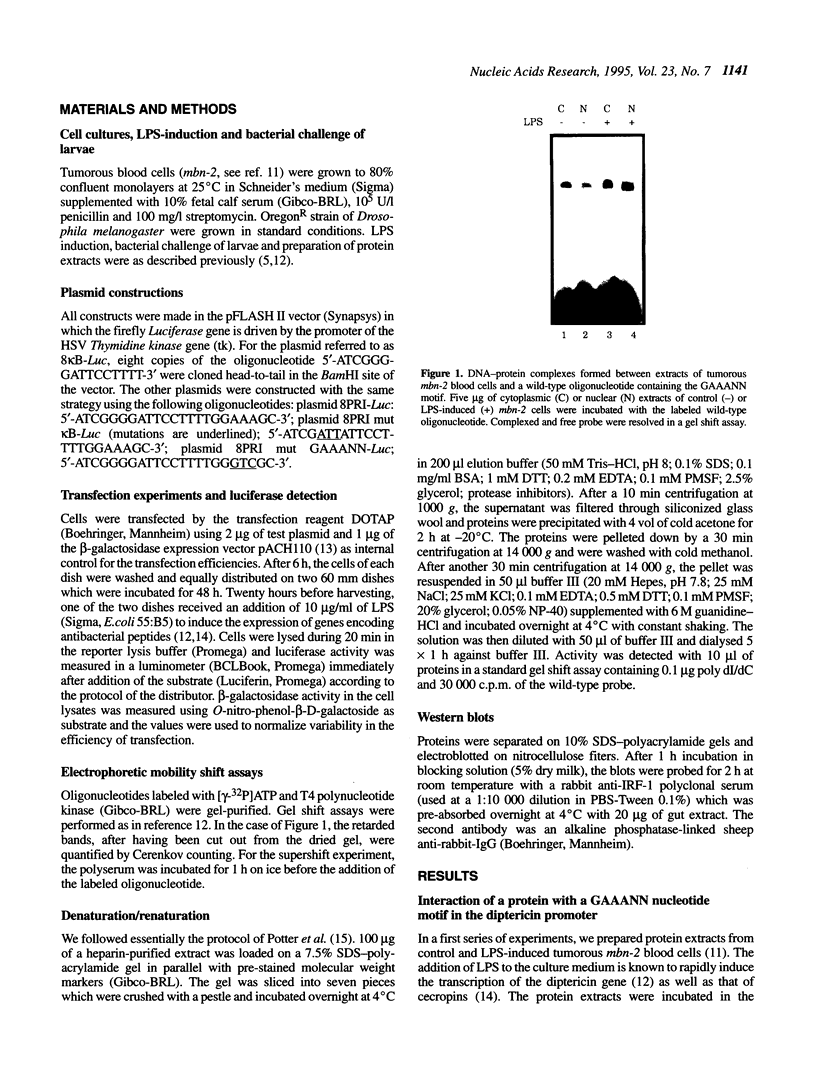
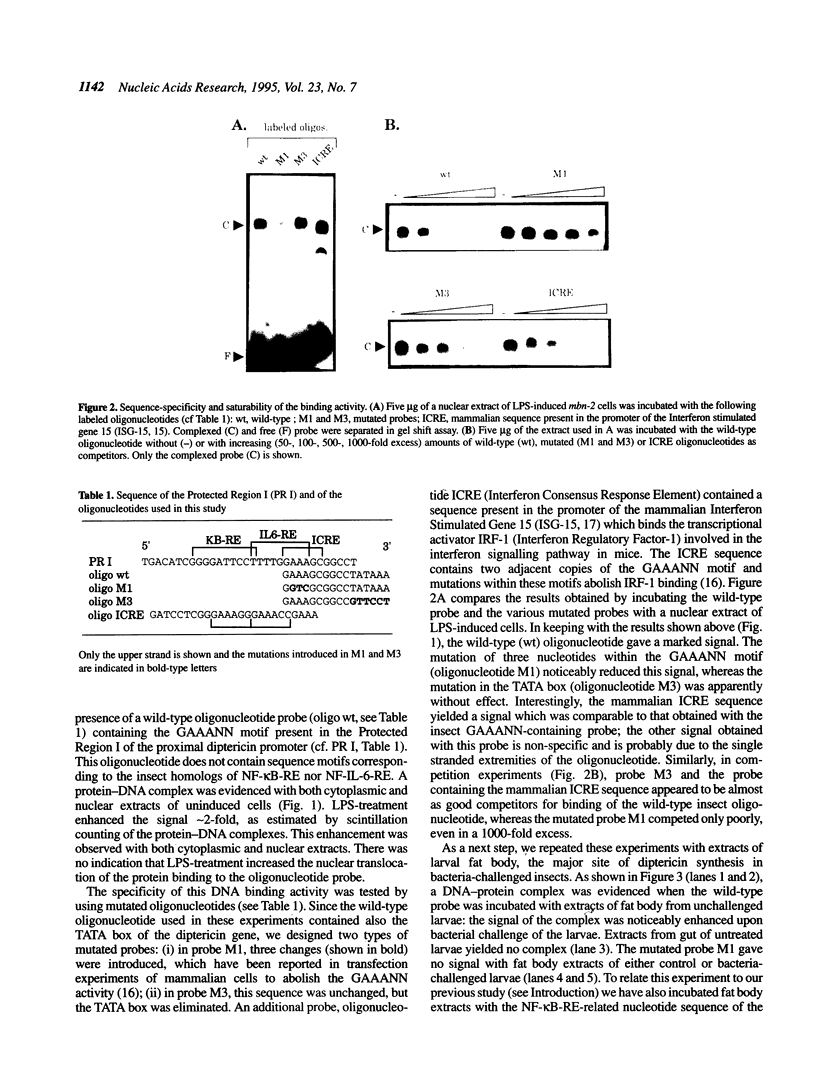
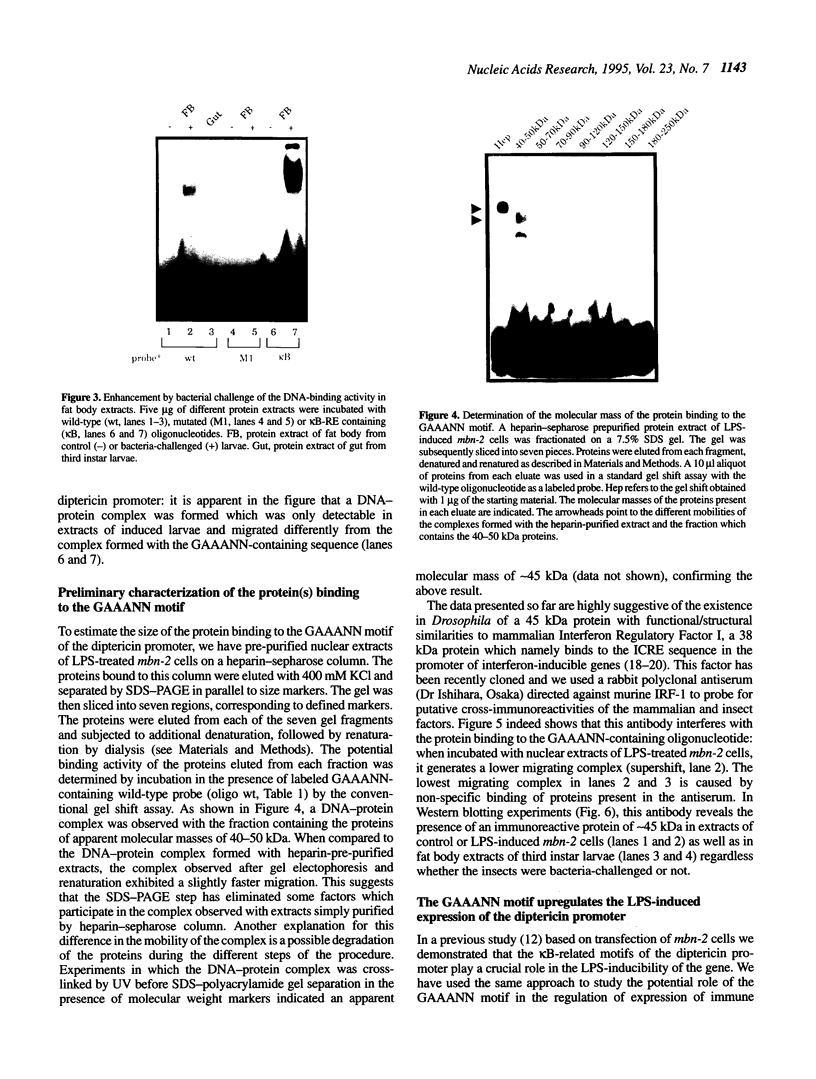
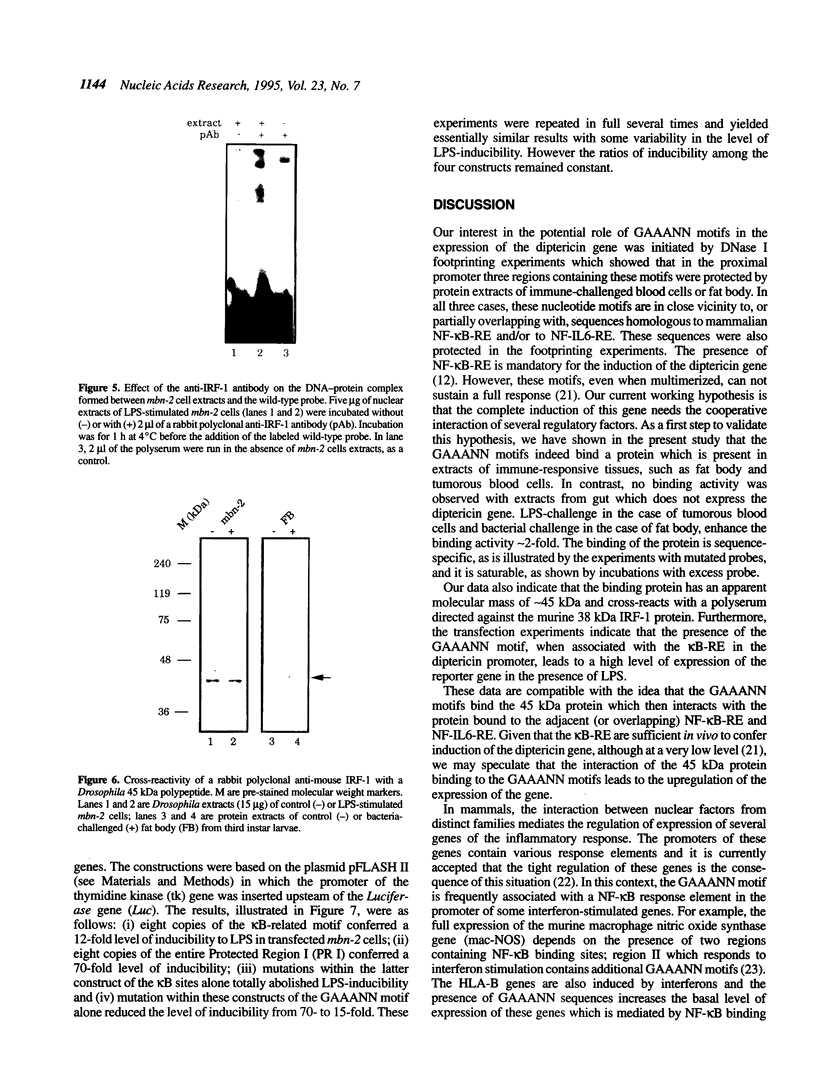
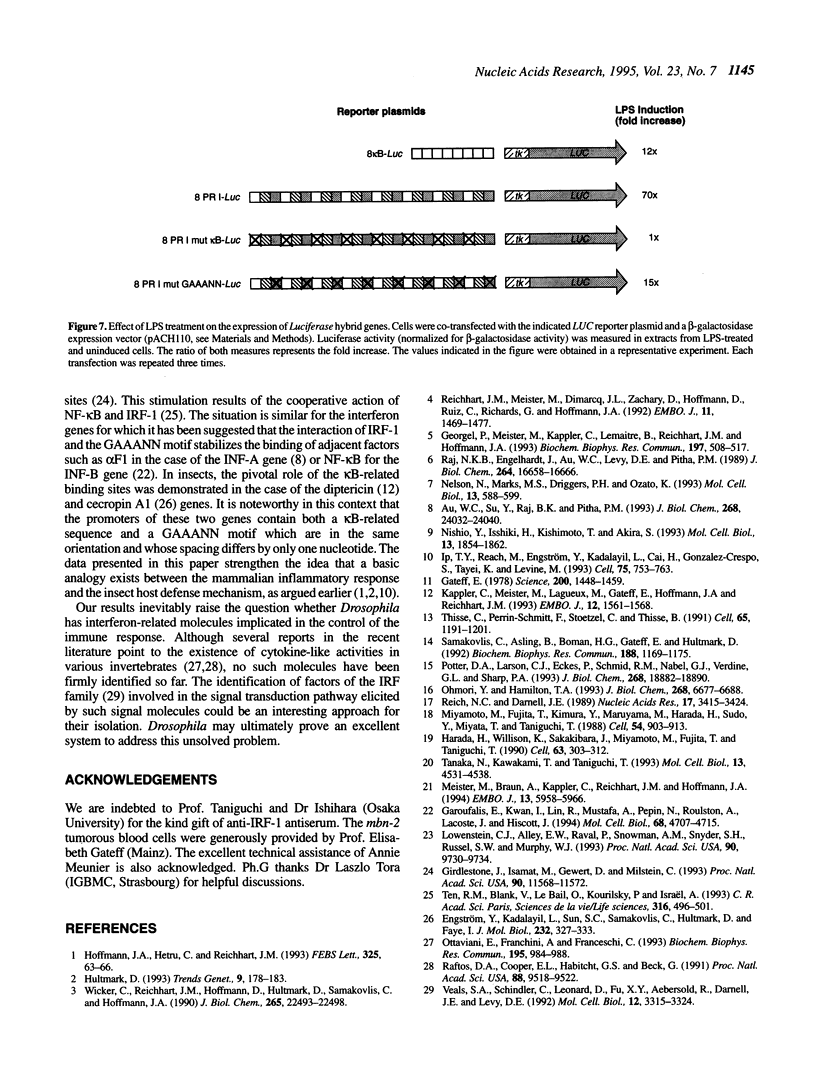
Images in this article
Selected References
These references are in PubMed. This may not be the complete list of references from this article.
- Au W. C., Su Y., Raj N. B., Pitha P. M. Virus-mediated induction of interferon A gene requires cooperation between multiple binding factors in the interferon alpha promoter region. J Biol Chem. 1993 Nov 15;268(32):24032–24040. [PubMed] [Google Scholar]
- Garoufalis E., Kwan I., Lin R., Mustafa A., Pepin N., Roulston A., Lacoste J., Hiscott J. Viral induction of the human beta interferon promoter: modulation of transcription by NF-kappa B/rel proteins and interferon regulatory factors. J Virol. 1994 Aug;68(8):4707–4715. doi: 10.1128/jvi.68.8.4707-4715.1994. [DOI] [PMC free article] [PubMed] [Google Scholar]
- Gateff E. Malignant neoplasms of genetic origin in Drosophila melanogaster. Science. 1978 Jun 30;200(4349):1448–1459. doi: 10.1126/science.96525. [DOI] [PubMed] [Google Scholar]
- Georgel P., Meister M., Kappler C., Lemaitre B., Reichhart J. M., Hoffmann J. A. Insect immunity: the diptericin promoter contains multiple functional regulatory sequences homologous to mammalian acute-phase response elements. Biochem Biophys Res Commun. 1993 Dec 15;197(2):508–517. doi: 10.1006/bbrc.1993.2508. [DOI] [PubMed] [Google Scholar]
- Girdlestone J., Isamat M., Gewert D., Milstein C. Transcriptional regulation of HLA-A and -B: differential binding of members of the Rel and IRF families of transcription factors. Proc Natl Acad Sci U S A. 1993 Dec 15;90(24):11568–11572. doi: 10.1073/pnas.90.24.11568. [DOI] [PMC free article] [PubMed] [Google Scholar]
- Harada H., Willison K., Sakakibara J., Miyamoto M., Fujita T., Taniguchi T. Absence of the type I IFN system in EC cells: transcriptional activator (IRF-1) and repressor (IRF-2) genes are developmentally regulated. Cell. 1990 Oct 19;63(2):303–312. doi: 10.1016/0092-8674(90)90163-9. [DOI] [PubMed] [Google Scholar]
- Hoffmann J. A., Hetru C., Reichhart J. M. The humoral antibacterial response of Drosophila. FEBS Lett. 1993 Jun 28;325(1-2):63–66. doi: 10.1016/0014-5793(93)81414-u. [DOI] [PubMed] [Google Scholar]
- Hultmark D. Immune reactions in Drosophila and other insects: a model for innate immunity. Trends Genet. 1993 May;9(5):178–183. doi: 10.1016/0168-9525(93)90165-e. [DOI] [PubMed] [Google Scholar]
- Ip Y. T., Reach M., Engstrom Y., Kadalayil L., Cai H., González-Crespo S., Tatei K., Levine M. Dif, a dorsal-related gene that mediates an immune response in Drosophila. Cell. 1993 Nov 19;75(4):753–763. doi: 10.1016/0092-8674(93)90495-c. [DOI] [PubMed] [Google Scholar]
- Kappler C., Meister M., Lagueux M., Gateff E., Hoffmann J. A., Reichhart J. M. Insect immunity. Two 17 bp repeats nesting a kappa B-related sequence confer inducibility to the diptericin gene and bind a polypeptide in bacteria-challenged Drosophila. EMBO J. 1993 Apr;12(4):1561–1568. doi: 10.1002/j.1460-2075.1993.tb05800.x. [DOI] [PMC free article] [PubMed] [Google Scholar]
- Lowenstein C. J., Alley E. W., Raval P., Snowman A. M., Snyder S. H., Russell S. W., Murphy W. J. Macrophage nitric oxide synthase gene: two upstream regions mediate induction by interferon gamma and lipopolysaccharide. Proc Natl Acad Sci U S A. 1993 Oct 15;90(20):9730–9734. doi: 10.1073/pnas.90.20.9730. [DOI] [PMC free article] [PubMed] [Google Scholar]
- Meister M., Braun A., Kappler C., Reichhart J. M., Hoffmann J. A. Insect immunity. A transgenic analysis in Drosophila defines several functional domains in the diptericin promoter. EMBO J. 1994 Dec 15;13(24):5958–5966. doi: 10.1002/j.1460-2075.1994.tb06941.x. [DOI] [PMC free article] [PubMed] [Google Scholar]
- Miyamoto M., Fujita T., Kimura Y., Maruyama M., Harada H., Sudo Y., Miyata T., Taniguchi T. Regulated expression of a gene encoding a nuclear factor, IRF-1, that specifically binds to IFN-beta gene regulatory elements. Cell. 1988 Sep 9;54(6):903–913. doi: 10.1016/s0092-8674(88)91307-4. [DOI] [PubMed] [Google Scholar]
- Nelson N., Marks M. S., Driggers P. H., Ozato K. Interferon consensus sequence-binding protein, a member of the interferon regulatory factor family, suppresses interferon-induced gene transcription. Mol Cell Biol. 1993 Jan;13(1):588–599. doi: 10.1128/mcb.13.1.588. [DOI] [PMC free article] [PubMed] [Google Scholar]
- Nishio Y., Isshiki H., Kishimoto T., Akira S. A nuclear factor for interleukin-6 expression (NF-IL6) and the glucocorticoid receptor synergistically activate transcription of the rat alpha 1-acid glycoprotein gene via direct protein-protein interaction. Mol Cell Biol. 1993 Mar;13(3):1854–1862. doi: 10.1128/mcb.13.3.1854. [DOI] [PMC free article] [PubMed] [Google Scholar]
- Ohmori Y., Hamilton T. A. Cooperative interaction between interferon (IFN) stimulus response element and kappa B sequence motifs controls IFN gamma- and lipopolysaccharide-stimulated transcription from the murine IP-10 promoter. J Biol Chem. 1993 Mar 25;268(9):6677–6688. [PubMed] [Google Scholar]
- Ottaviani E., Franchini A., Franceschi C. Presence of several cytokine-like molecules in molluscan hemocytes. Biochem Biophys Res Commun. 1993 Sep 15;195(2):984–988. doi: 10.1006/bbrc.1993.2141. [DOI] [PubMed] [Google Scholar]
- Potter D. A., Larson C. J., Eckes P., Schmid R. M., Nabel G. J., Verdine G. L., Sharp P. A. Purification of the major histocompatibility complex class I transcription factor H2TF1. The full-length product of the nfkb2 gene. J Biol Chem. 1993 Sep 5;268(25):18882–18890. [PMC free article] [PubMed] [Google Scholar]
- Raftos D. A., Cooper E. L., Habicht G. S., Beck G. Invertebrate cytokines: tunicate cell proliferation stimulated by an interleukin 1-like molecule. Proc Natl Acad Sci U S A. 1991 Nov 1;88(21):9518–9522. doi: 10.1073/pnas.88.21.9518. [DOI] [PMC free article] [PubMed] [Google Scholar]
- Raj N. B., Engelhardt J., Au W. C., Levy D. E., Pitha P. M. Virus infection and interferon can activate gene expression through a single synthetic element, but endogenous genes show distinct regulation. J Biol Chem. 1989 Oct 5;264(28):16658–16666. [PubMed] [Google Scholar]
- Reich N. C., Darnell J. E., Jr Differential binding of interferon-induced factors to an oligonucleotide that mediates transcriptional activation. Nucleic Acids Res. 1989 May 11;17(9):3415–3424. doi: 10.1093/nar/17.9.3415. [DOI] [PMC free article] [PubMed] [Google Scholar]
- Reichhart J. M., Meister M., Dimarcq J. L., Zachary D., Hoffmann D., Ruiz C., Richards G., Hoffmann J. A. Insect immunity: developmental and inducible activity of the Drosophila diptericin promoter. EMBO J. 1992 Apr;11(4):1469–1477. doi: 10.1002/j.1460-2075.1992.tb05191.x. [DOI] [PMC free article] [PubMed] [Google Scholar]
- Samakovlis C., Asling B., Boman H. G., Gateff E., Hultmark D. In vitro induction of cecropin genes--an immune response in a Drosophila blood cell line. Biochem Biophys Res Commun. 1992 Nov 16;188(3):1169–1175. doi: 10.1016/0006-291x(92)91354-s. [DOI] [PubMed] [Google Scholar]
- Tanaka N., Kawakami T., Taniguchi T. Recognition DNA sequences of interferon regulatory factor 1 (IRF-1) and IRF-2, regulators of cell growth and the interferon system. Mol Cell Biol. 1993 Aug;13(8):4531–4538. doi: 10.1128/mcb.13.8.4531. [DOI] [PMC free article] [PubMed] [Google Scholar]
- Ten R. M., Blank V., Le Bail O., Kourilsky P., Israël A. Two factors, IRF1 and KBF1/NF-kappa B, cooperate during induction of MHC class I gene expression by interferon alpha beta or Newcastle disease virus. C R Acad Sci III. 1993;316(5):496–501. [PubMed] [Google Scholar]
- Thisse C., Perrin-Schmitt F., Stoetzel C., Thisse B. Sequence-specific transactivation of the Drosophila twist gene by the dorsal gene product. Cell. 1991 Jun 28;65(7):1191–1201. doi: 10.1016/0092-8674(91)90014-p. [DOI] [PubMed] [Google Scholar]
- Veals S. A., Schindler C., Leonard D., Fu X. Y., Aebersold R., Darnell J. E., Jr, Levy D. E. Subunit of an alpha-interferon-responsive transcription factor is related to interferon regulatory factor and Myb families of DNA-binding proteins. Mol Cell Biol. 1992 Aug;12(8):3315–3324. doi: 10.1128/mcb.12.8.3315. [DOI] [PMC free article] [PubMed] [Google Scholar]
- Wicker C., Reichhart J. M., Hoffmann D., Hultmark D., Samakovlis C., Hoffmann J. A. Insect immunity. Characterization of a Drosophila cDNA encoding a novel member of the diptericin family of immune peptides. J Biol Chem. 1990 Dec 25;265(36):22493–22498. [PubMed] [Google Scholar]







